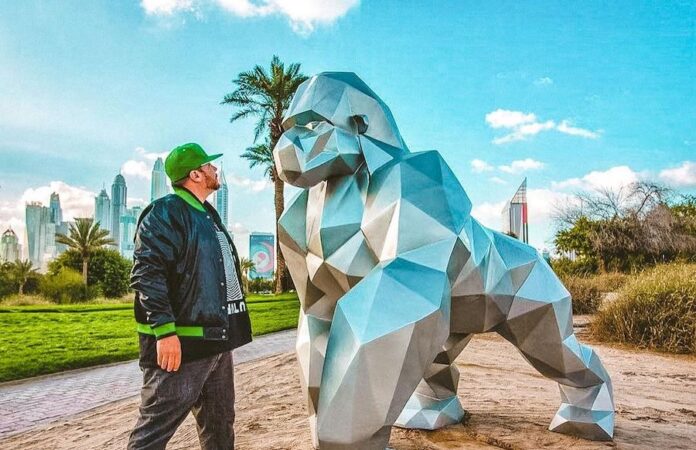DUBAI: Visitors to the UAE will not failed to have noticed the geometric, larger-than-life statues of gorillas, bears and turtles sprinkled around the emirates in recent months. The 3D polygon sculptures that can be found in restaurants like Nusr-Et at the Four Seasons, Jumeirah, or on the beachfront of the Burj Al-Arab are the brainchild of Tunisian-French artist Idriss B.
The Dubai-based artist who recently relocated to the UAE from France, launched his very own non-fungible tokens (NFTs) titled “Polyverse Art” — a collection of 11,000 digital animal sculptures with their own unique names and distinct personalities. The virtual art pieces launched on the Ethereum blockchain last month.
His sculptures can be found dotted throughout the UAE. Supplied
For the crypto uninitiated, an NFT is any digital file, be it GIFs, JPEGs, tweets, MP3s and MP4s, to name a few. Each NFT boasts a serial number which proves ownership. You own the token and that information is stored on a blockchain, which is an unbreakable digital ledger.
The artist told Arab News that he believes NFTs are the future of art, so it made sense for him to go in that direction.
“NFT’s are part of the future and the art world will embrace this new medium completely,” he said.
The launched his very own non-fungible tokens (NFTs) titled “Polyverse Art.” Supplied
In addition to being a proud owner of Idriss B’s art in the metaverse, crypto-enthusiasts who purchase one of his NFTs also receive a physical piece of art, in addition to real life benefits such as exclusive access to private concerts, fashion shows, gallery openings and NBA games, according to the artist’s website polyverseart.io.
Idriss B. is among the growing number of artists embracing digital art. Even major auction houses such as Christies, international galleries and renowned exhibitions including Art Basel are selling and trading NFTs.
The artist believes that there are plenty of benefits of owning one of his NFTs. “You get to acquire a rare product while getting access to exclusive giveaways and interactive experiences,” he said.
Crypto-enthusiasts who purchase one of his NFTs also receive a physical piece of art. Supplied
Artists stand to benefit from launching NFTs too.
Mike Winkelmann — the digital artist known as Beeple — sold an NFT of his work “Everydays – The First 5000 Days” for $69 million at Christie’s, making it the third-most expensive work ever by a living artist.
Prior to the Christie’s auction in March, the most Beeple had ever sold a print for was $100.
In addition to generating profit, artists and content creators are able to retain their full copyright and interact with a larger community.
“NFTs allow artists to directly connect with thousands of people,” said Idriss B. “It’s about being a part of something bigger.”

